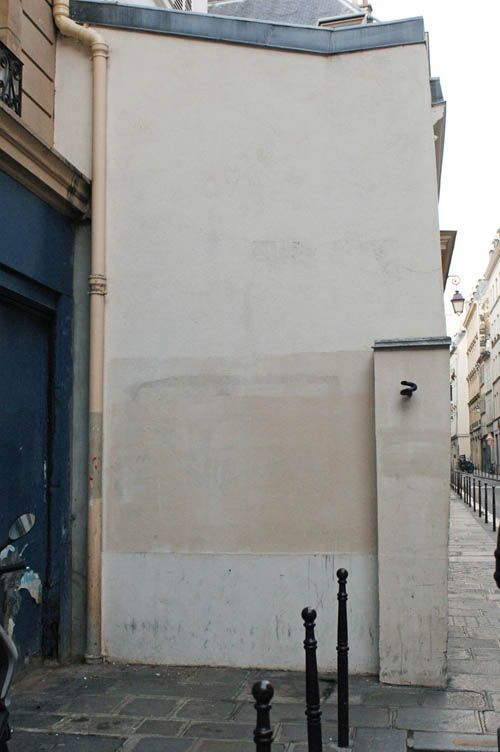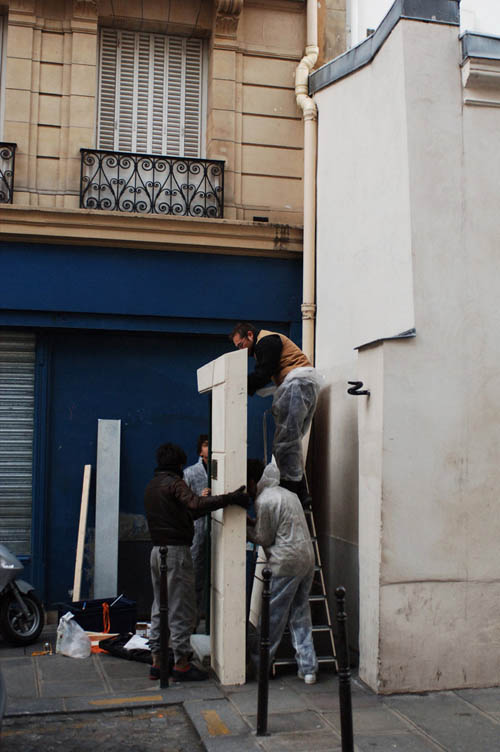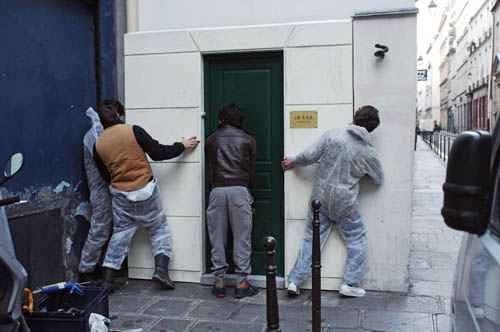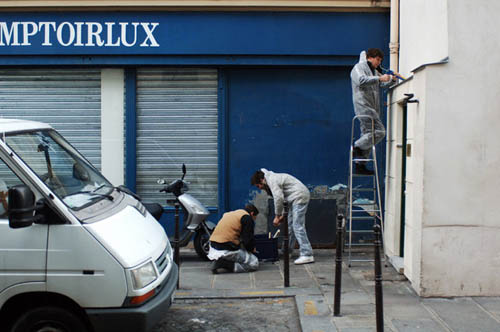 [Image: From Les spécialistes by Julien Berthier and Simon Boudvin].
[Image: From Les spécialistes by Julien Berthier and Simon Boudvin].
Back in 2006, early on a Saturday morning, artists Julien Berthier and Simon Boudvin installed a new door in the city of Paris—but it was a fake door, leading nowhere, on an otherwise empty wall in the 3rd arrondissement. [Image: From Les spécialistes by Julien Berthier and Simon Boudvin].
[Image: From Les spécialistes by Julien Berthier and Simon Boudvin].
The project was called Les spécialistes. "The façade, using the local architectural codes, occupies 10 cm of public space," Berthier explains, "and was mounted and glued on in thirty minutes."


 [Images: From Les spécialistes].
[Images: From Les spécialistes].
Unbelievably, Berthier adds, "Almost 4 years later, the address still exists. Regularly graffitied it is even cleaned by the city service.” [Image: Les spécialistes seen in 2009; its co-creator, Julien Berthier, has a flair for secret doors].
[Image: Les spécialistes seen in 2009; its co-creator, Julien Berthier, has a flair for secret doors].
In a way, I'm reminded of an article published last month in New York magazine called "There’s a Brownstone in Brooklyn With a Secret Passage to the Subway." There, the magazine wrote that "among the lovely three-story brownstones in Brooklyn is one extra-special home, one that really isn't a home at all. It's merely a façade that serves to disguise a passage into the dark subway tunnel" below. An emergency evacuation-and-access system for the subway, the doorway and its Potemkin house remain unmarked and undisclosed; it is the NYPD as Julien Berthier. (Which, in turn, reminds me of the Rentable Basement Maze).
But, of course, these sorts of "fake" spaces are not uncommon at all. There are also "dummy houses" in London—specifically at 23-24 Leinster Gardens—that were constructed from the very beginning as nothing but façades. They don't even have interiors; they are simply vents for the Underground, disguised as faux-Georgian flats. Check out some cool photos of them over at Urban 75.
This further brings to mind, however, a scene from Umberto Eco's underappreciated novel Foucault's Pendulum, where the narrator, being regaled with tales of subterranean Paris, is told that, "People walk by and they don't know the truth... That the house is a fake. It's a façade, an enclosure with no room, no interior. It is really a chimney, a ventilation flue that serves to release the vapors of the regional Métro. And once you know this you feel you are standing at the mouth of the underworld..."
Fake buildings and fake doors with secret interiors—or interiors that don't even exist. Purloined interiority.
Might I suggest, then, in light of these examples, that if someone, someday, were to approach Berthier's Door—after all, it deserves a name, capitalized and cartographically handed down friend-to-friend in a countergeography of the city—and finds themselves able to open it, to step through into a labyrinth of staircases and rooms stacked one on top the other leading down dozens of meters, and they are then able to explain later, after emerging somewhere perhaps near Dijon, what marvels of literally suburban cross-connection exist back there in a knitted fabric of minor spaces no one else has ever seen, that art, architecture, and mythology will finally have experienced their rightful co-identification. [Image: Berthier's Door—near 1 Rue Chapon—visible on Google Street View].
[Image: Berthier's Door—near 1 Rue Chapon—visible on Google Street View].
Or, perhaps, if someone installs a door of their own—atop a hill in the 19th arrondissement, or down on a side-street near the Musée des arts et métiers, site of the now-irreparably damaged Foucault's Pendulum, or over in Moscow somewhere with its rumored secret subway—a maze of connective spaces will open up between them—indeed, wherever you install a door, in any city, if you simply wait long enough, the invisible network of tunnels burrowing away in the background of urban awareness will eventually come to find it.
Lưu trữ Blog
-
▼
2010
(3068)
-
▼
tháng 5
(246)
- Nu börjar det!
- Pix
- Round Mountain Spring Time Trial
- Where are the Electric Snails now?
- THE BEACH BOYS - SMiLE
- The End of the Red Rock Season
- Commonman
- Helgen före The Helg
- How Not to Act Old.
- Week Ending May 30 (WS - 4 Weeks)
- Sack the Stylist
- KLAXONS - FLASHOVER
- Reusable Cupcake Shopping Bag
- Simple Sausage Rolls
- June and July Climbing Events
- Superhelg
- Onion-flavored?
- Mixed Berry Meringue Pie
- Playlist - 29th May 2010
- Princess Cupcake Cake
- Plume moth
- Bloggers in the Archive
- Weekend Warrior - Videos to get you stoked!
- A special book stack
- Walker buggy
- FICTIONALISED BROOKLYN
- Multiple Climbers Evacuated from Denali this Week
- ARCADE FIRE - THE SUBURBS / MONTH OF MAY
- The Ice Bollard
- 11.6. CANCELED
- Me and Joe
- CATB Poster update
- Ny torsdagsvana
- Climbing and Outdoor News from Here and Abroad - 5...
- And By Contrast...
- Did Somebody Say Snow in the Sierras?
- Doctor's Orders
- CHARLOTTE GAINSBOURG - TIME OF THE ASSASSINS
- Quick Links 11
- Conditions Report - May 26 2010
- What the adrenalin did
- Tjemiddag
- Dear Mr Woog and Woog Jr's
- Franklin St. Brooklyn
- Week Ending May 23 (WS - 5 Weeks)
- The Chelsea Teapot
- Kent St, Brooklyn
- Avenue C, Manhattan
- The Fires
- Towel Day 2010
- JOHN GRANT - QUEEN OF DENMARK + I WANNA GO TO MARZ
- SHOUT OUT LOUDS - SHOW ME SOMETHING NEW
- Rethinking the Camelbak
- Boob Economics - A Public Humiliation Announcement
- Fyrahundringar med sällskap
- My first phone call.
- Greenpoint Ave, Greenpoint
- Carroll St. Brooklyn
- Opposite New Museum, Bowery, Manhattan
- Midnite Cookie
- Berthier's Door
- Fabulous Fabbers
- Franklin St. Brooklyn
- Bowery, Manhattan
- Arresting a Crevasse Fall with a Rope
- Pac-Man anniversary
- Äntligen ute-army!
- Eat Pray Love Sleep Eat Drink Smoke Sleep
- Jemez Mountain 50 Miler
- May and June Climbing Events
- Varmt och trångt men kul ändå
- Den där tävlingen..
- Sunday affirmations
- It's goodbye for a week
- Playlist - 22nd May 2010
- Sicksack i solen
- Weekend Warrior - Videos to get you STOKED
- Hihi
- PHOTOGRAPHY BY AARON LOUIS FOWLER
- Downtown Brooklyn
- Manhattan buildings from 8th Ave Williamsburg
- Franklin St. Brooklyn
- Google versus Apple
- From Bryant Park, Manhattan
- Manhattan buildings from Dumbo
- From Bryant Park, Manhattan
- Friday Nature
- Ascending Systems
- BLUE HAWAII - BLOOMING SUMMER
- TORO Y MOI - SIDES OF CHAZ
- Sommarminnen
- Working with caustic soda
- Infinite Arms
- Greenpoint Ave, Greenpoint
- ARCADE FIRE ARE A TEASE
- Soho somewhere
- Greenpoint, Lorimer Ave.
- Greenpoint Ave, Greenpoint
- PHOTOGRAPHY BY JILL GREENBERG
- Jemez and some other bits and pieces
-
▼
tháng 5
(246)